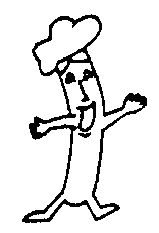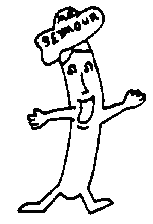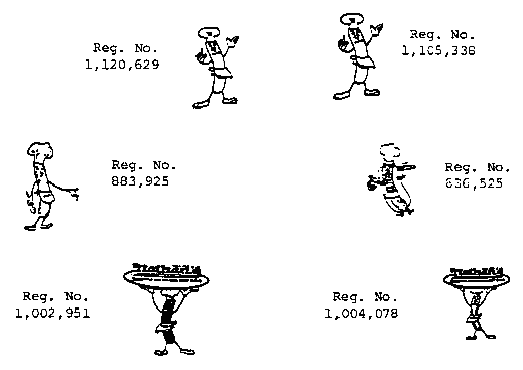*1 IN RE VIENNA SAUSAGE MANUFACTURING COMPANY
Serial No. 727,101
May 14, 1990
Lockwood, Alex, Fitzgibbon & Cummings for applicant
Mary C. Schimelfenig
Trademark Examining Attorney
Law Office 6
(Ronald E. Wolfington, Managing Attorney)
Before Rooney, Seeherman and Quinn
Members
Opinion by Rooney
An application was filed by Vienna Sausage Manufacturing Company to register the design mark shown below for frankfurters. Use since February 17, 1988 has been alleged.

Registration was refused under Section 2(d) of the Trademark Act in view of registrations of the marks shown below for, respectively, processed meat products, namely, beef frankfurters, salami, pastrami and bologna; [FN1] restaurant and catering services; [FN2] catering services; [FN3] combination package frankfurters, rolls and mustard; [FN4] salami; [FN5] and catering services [FN6] on the ground that applicant's mark so resembles registrant's marks as to be likely to cause confusion, mistake or deception.
In response, applicant filed an amendment to the mark sought to be registered, namely, the addition thereto of the name, MR. SEYMOUR, as shown below.

Citing TMEP Section 807.14, the Examining Attorney stated that the amendment was unacceptable because it was deemed to be a material alteration of the mark for which the application was filed. The refusal to register under Section 2(d) was made final. Applicant appealed.
Applicant frames the issues of the case as being (a) should the refusal of the Examining Attorney to treat the amendment to the drawing as acceptable and ignore this amendment in making her final refusal to register be affirmed (b) should the final refusal to register the originally applied for mark be affirmed and (c) should applicant's mark as amended be refused registration.
Applicant argues, regarding the amendment, that the Examining Attorney should have applied the "flexible" approach mentioned in Section 807.14(a) since this amendment would not have required a new search in view of special circumstances present in this case. The special circumstances cited are that there was a companion application filed at the same time as application Ser. No. 727,101 for the mark MR. SEYMOUR; that the same Examining Attorney had handled that application, searched it and cited a prior registration (Regn. No. 1,427,652 for the mark SEYMOUR for butter) against it and the companion application was abandoned. Consequently, argues applicant, the original search done for MR. SEYMOUR could have served for the amendment to the mark in this application.
Rule 2.72 states, in pertinent part:
... Amendments may not be made if the character of the mark is materially altered.
Section 807.14(a) Trademark Manual of Examining Procedure states:
An amendment may not be made if the mark is materially altered by the amendment. 37 CFR Section 2.72. This possibility more frequently arises when matter is added to the mark than when matter is deleted from the mark. It is for the Examining Attorney to decide whether the mark is materially altered by the amendment. The rule should be applied with flexibility, in order not to create a burden for the Examining Attorney in making additional searches and in order not to create a burden for the applicant in filing additional applications. Almost any amendment for which the Examining Attorney believes there is justification may be made, except that the Examining Attorney should not accept an amendment which would result in the substitution of a completely different mark for the original mark.
*2 We are in agreement with the Examining Attorney's argument that the admonishment to apply the rule with flexibility is not the standard to be applied in deciding whether to accept an amendment. Section 7(e) [formerly (d) ] of the Trademark Act provides, in part, that
"... the Commissioner for good cause may permit any registration to be amended or to be disclaimed in part: Provided, that the amendment or disclaimer does not alter materially the character of the mark ..."
The Trademark Manual of Examining Procedure Section 807.14(a) and Rule 2.72 both express the standard as it is set by Section 7. What is considered a material alteration has been addressed in several cases, all of which agree, in essence, that the new and old forms of the mark must create the same general commercial impression or create the impression of being essentially the same mark. See In re The Wine Society of America, Inc., 12 U.S.P.Q.2d 1139 (TTAB 1989); In re Nationwide Industries inc., 6 U.S.P.Q.2d 1882 (TTAB 1988); In re Pierce Foods Corposation, 230 USPQ 307 (TTAB 1986); Visa International Service Association v. Life-Code Systems, Inc., 220 USPQ 740 (TTAB 1983). [FN7] The question of whether a new search is necessitated by the amendment is a factor to be considered but is not the determining element of whether or not to accept the amendment.
In this case, we are of the view that the addition of the words MR. SEYMOUR to the drawing materially changes the commercial impression of the mark and is, thus, a material alteration of the mark. The refusal to allow the amendment was therefore correct.
Turning to the question of likelihood of confusion between the cited marks and the applied-for mark as used on the recited goods, we note initially that goods and/or services need not be identical or even competitive in order to support a finding that confusion is likely to result from the use of similar marks thereon. It is sufficient for that purpose that the goods and/or the circumstances surrounding their marketing are such that they would be likely to be encountered by the same persons under conditions that could give rise to the mistaken belief, because of the marks used thereon, that they emanate from or are in some way associated with the same source. See In re Mucky Duck Mustard Co., 6 U.S.P.Q.2d 1467 (TTAB 1988).
In this case, the goods are identical in part and are otherwise closely related. Indeed, applicant has not contended that its goods are different from registrant's, but only that its mark is distinct from registrant's marks. Specifically, applicant argues that its mark is registrable over registration No. 1,120,629 and that, if registrable over that mark, the assertedly closest of the cited marks, it should also be registered over the other five registrations cited. [FN8]
*3 Applicant has argued that the mark in its application differs from registrant's marks. Applicant points out what it considers to be specific differences in each mark, such as, distinctly different feet, an apron on the figure in registrant's marks which does not appear in applicant's mark, differences in the outstretched arms and hands, the facial features and the shapes of the chef's hats.
With regard to this argument, applicant is advised that where the question of likelihood of confusion to be decided involves design marks which are not capable of being spoken, the question of the similarity of the marks must be determined primarily on the basis of their visual similarity. Undoubtedly, if the marks were placed side by side for comparison, specific differences in them could be detected and those differences might well be enough to distinguish one from the other. See Matsushita Electric Industrial Co., Ltd. v. Sanders Associates, Inc., 177 USPQ 720 (TTAB 1973) and cases cited therein. However, that is not the case. It is highly unlikely that the marks of these parties would be viewed together. When such marks are seen at different times on such similar goods, the recollection of the first viewed mark will be a general impression most likely devoid of the details noted by applicant. What will be remembered will be a figure of a frankfurter having arms, legs, a pleasant facial feature and a chef's hat. It is noteworthy also that the goods are not expensive and are purchased with less than a great deal of care.
The foregoing is equally true with regard to the marks in registrant's Regns. No. 1,120,629, 1,105,338, and 883,925. The mark in Regn. No. 636,525 is more detailed, but is not so different from the others as to preclude a likelihood of confusion. The marks shown in Regn. Nos. 1,002,951 and 1,004,078 differ in that each has added what appears to be a tray held over the head, on which are the words "NATHAN'S Famous, Inc., Since 1916, More than just the best HOT DOG." However, the figures in these marks are quite similar to those of registrant's other marks and to applicant's mark. It is our opinion that there is a likelihood of confusion as to source with respect to all of these marks. We believe it likely that one familiar with any of registrant's marks would, upon seeing applicant's mark used on the same or related goods, assume a common source.
In view of the foregoing, the refusal to register is affirmed and registration to applicant is refused.
L.E. Rooney
E.J. Seeherman
T.J. Quinn
Members, Trademark Trial and Appeal Board
FN1. Regn. No. 1,120,629 issued June 19, 1979, Section 8 affidavit accepted, Section 15 affidavit filed.
FN2. Regn. No. 1,105,338 issued October 31, 1978, Section 8 affidavit accepted, Section 15 affidavit accepted.
FN3. Regn. No. 883,925 issued January 6, 1970, Section 8 affidavit accepted, Section 15 affidavit filed.
FN4. Regn. No. 636,525 issued October 30, 1956, Section 8 affidavit accepted, Section 15 affidavit filed, renewed.
FN5. Regn. No. 1,002,951 issued January 28, 1975, Section 8 affidavit accepted, Section 15 affidavit filed.
FN6. Regn. No. 1,004,078 issued February 4, 1975, Section 8 affidavit accepted, Section 15 affidavit filed.
FN7. In the case of In re The Wine Society of America, Inc., supra, it was recommended by the Board that, to the extent that the language of Section 807.14(a) describes a standard of "material alteration" which differs from that set forth in the cases noted above, revision of that section was in order. As a result, Trademark Examining Guide No. 2-89 was issued on October 6, 1989. The provisions thereof will be incorporated into the TMEP at the next revision.
FN8. Applicant also states that, if registrable over the noted registration, it will also be registrable over, not only the other five cited registrations, but the new set of registrations relied on. Applicant is apparently referring to registrations mentioned in the second Office action as illustrating that "a single entity can and does provide the goods and services under a single mark." Applicant is advised that these registrations were not citations under Section 2(d) as bars to registration, but only for the purpose stated by the Examining Attorney.


